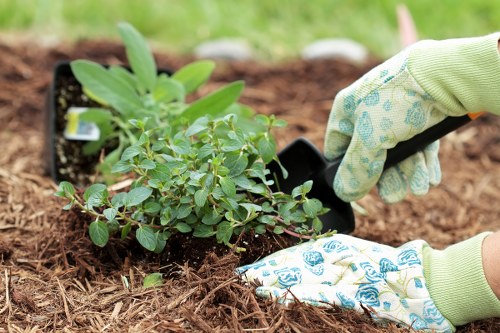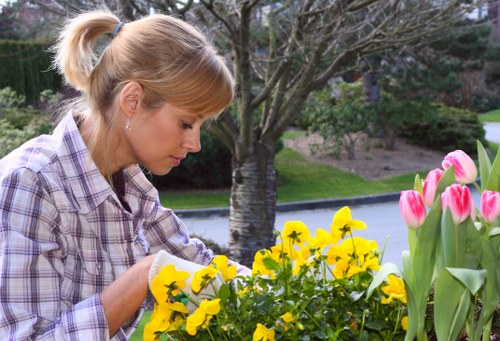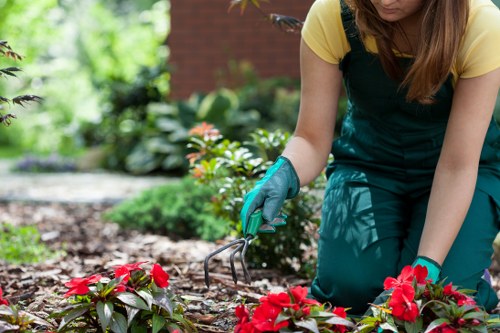Effective Driveway Algae Removal in St Pauls Cray

Driveway algae can be a persistent and unsightly problem for homeowners in St Pauls Cray. The damp climate and shaded areas around driveways create an ideal environment for algae growth, which not only mars the appearance of your property but can also make surfaces slippery and hazardous.
Addressing algae growth promptly is essential to maintain the safety and aesthetic appeal of your driveway. Fortunately, with the right strategies and professional help, you can effectively remove algae and prevent its return.
In this article, we will explore various methods for driveway algae removal in St Pauls Cray, offering practical solutions tailored to the local climate and conditions.

Understanding Driveway Algae
Algae are simple, plant-like organisms that thrive in moist environments. On driveways, algae growth is often green or black and can cover large areas, especially in shaded spots.
The presence of algae on your driveway is more than just a cosmetic issue. It can make the surface slippery, increasing the risk of falls, and can contribute to the deterioration of driveway materials over time.
Identifying the type of algae present is the first step in effective removal. Common types include green algae, black algae, and moss, each requiring slightly different treatment approaches.

Methods for Removing Algae from Driveways
1. Manual Cleaning
Manual cleaning involves scrubbing the driveway with a stiff brush and water. This method can be effective for small areas of algae but may require significant effort for larger infestations.
2. Chemical Treatments
Chemical treatments, such as bleach or commercially available algae removers, can effectively eliminate algae. It’s important to follow the manufacturer’s instructions to prevent damage to the driveway surface.
3. Pressure Washing
Pressure washing uses high-pressure water to remove algae and other debris from the driveway. This method is efficient for large areas but should be performed by professionals to avoid damaging the surface.

Preventing Algae Growth
Preventing algae growth is often easier than removing it. Here are some preventative measures:
- Proper Drainage: Ensure that water drains away from the driveway to reduce moisture levels.
- Regular Cleaning: Keep the driveway clean from leaves and debris that can retain moisture.
- Sun Exposure: Trim nearby vegetation to allow more sunlight to reach the driveway, making it less hospitable for algae.
- Sealing: Apply a sealant to the driveway surface to create a barrier against moisture and algae growth.
Using Eco-Friendly Solutions
Consider using eco-friendly cleaning solutions to remove and prevent algae. Ingredients like vinegar, baking soda, and hydrogen peroxide can be effective and are less harmful to the environment.

Hiring Professional Services
For extensive algae problems, hiring a professional driveway cleaning service in St Pauls Cray can be the most effective solution. Professionals have access to specialized equipment and eco-friendly products that can thoroughly remove algae and prevent its return.
When choosing a professional service, consider the following:
- Experience and reputation in algae removal.
- Use of environmentally safe cleaning agents.
- Customer reviews and testimonials.
- Cost and service guarantees.
Investing in professional services can save time and ensure the longevity of your driveway’s appearance and safety.
Local Expertise in St Pauls Cray and Surrounding Areas
St Pauls Cray is surrounded by several neighborhoods and communities, each with unique characteristics that can influence algae growth and driveway maintenance. Understanding these local nuances can help tailor the best algae removal strategies.
- Crystal Palace: Close proximity to parks and green spaces increases moisture levels, making algae prevention crucial.
- Kindersley Green: Residential areas with many trees require regular driveway cleaning to manage falling leaves and debris.
- Brentwood: Older homes with paved driveways may benefit from sealing to prevent algae penetration.
- Hither Green: Proximity to schools and public areas means higher foot traffic, necessitating safe and clean driveways.
- Orpington: Mixed residential and commercial areas may require different cleaning approaches depending on driveway usage.
- Petts Wood: Rural surroundings can lead to more organic debris accumulation on driveways.
- Elmstead: Affluent areas may prefer eco-friendly and aesthetically pleasing algae removal solutions.
- North Cray: High humidity levels make regular algae inspections necessary.
- Singers Hill: Newer developments might have modern driveway materials requiring specific cleaning methods.
- Bickley Village: Heritage properties may need gentle cleaning techniques to preserve driveway surfaces.
Choosing the Right Algae Removal Service in Nearby Areas
When selecting an algae removal service, consider how the specific needs of your area align with the service provider’s expertise. Here are tips for some nearby areas:
- Petts Wood: Look for services that handle heavy debris and offer regular maintenance plans.
- Brentwood: Choose companies experienced in working with older driveways and historical properties.
- Hither Green: Opt for services that ensure minimal disruption in high-traffic residential neighborhoods.
- Kindersley Green: Select providers who can manage large areas and frequent algae growth.
- Orpington: Find services that offer both residential and commercial driveway cleaning solutions.
Cost of Algae Removal in St Pauls Cray
The cost of algae removal can vary based on the size of the driveway, the extent of algae growth, and the chosen removal method. Here are some general price considerations:
- Manual Cleaning: Generally the most affordable option, costing between £50 and £150 depending on the driveway size.
- Chemical Treatments: Costs range from £100 to £300, including necessary materials and labor.
- Pressure Washing: Typically priced between £150 and £500, influenced by driveway dimensions and condition.
- Professional Services: Comprehensive packages, including prevention measures, may cost upwards of £300.
Investing in regular maintenance can reduce long-term costs by preventing severe algae infestations that require more intensive and expensive treatments.
Environmental Considerations
When removing algae, it’s important to consider the environmental impact of the methods and products used:
- Eco-Friendly Cleaners: Using natural ingredients minimizes harm to surrounding flora and fauna.
- Water Usage: Methods that conserve water, such as manual scrubbing or low-pressure washing, are more sustainable.
- Proper Disposal: Ensure that runoff containing algae and cleaning agents is disposed of responsibly to avoid pollution.
Choosing environmentally responsible algae removal methods benefits both your property and the broader ecosystem in St Pauls Cray.
Long-Term Maintenance Tips
To keep your driveway free from algae, implement the following long-term maintenance practices:
- **Regular Inspections:** Check your driveway periodically for early signs of algae growth.
- **Keep it Clean:** Remove leaves, dirt, and debris that can retain moisture and promote algae.
- **Improve Drainage:** Ensure that water flows away from the driveway to reduce dampness.
- **Increase Sunlight Exposure:** Trim overhanging branches to allow more sunlight, which inhibits algae growth.
- **Apply Sealant:** Periodically sealing your driveway can provide a protective barrier against moisture and algae.
Consistent maintenance not only prevents algae but also extends the lifespan of your driveway.
Safety Precautions During Algae Removal
When removing algae, safety should be a top priority. Here are some precautions to consider:
- Protective Gear: Wear gloves, goggles, and appropriate clothing to protect against cleaning agents and debris.
- Proper Ventilation: If using chemical treatments, ensure adequate ventilation to avoid inhaling fumes.
- Safe Handling of Chemicals: Follow all safety instructions when using chemical cleaners to prevent accidents.
- Secure Area: Keep the work area clear of children and pets during the cleaning process.
Adhering to safety guidelines ensures a risk-free algae removal process.
DIY vs. Professional Algae Removal
Deciding between DIY methods and hiring professionals depends on several factors:
DIY Algae Removal
- Cost-Effective: DIY methods can save money but may require more time and effort.
- Control: You have complete control over the cleaning process and can tailor methods to your preferences.
- Skill Level: Requires some knowledge and physical effort to effectively remove algae.
Professional Algae Removal
- Expertise: Professionals have the experience and tools to handle severe algae infestations efficiently.
- Time-Saving: Saves you time and effort, allowing you to focus on other responsibilities.
- Guaranteed Results: Many services offer guarantees on their work, providing peace of mind.
Evaluate your specific situation to determine the best approach for your driveway algae removal needs.
Choosing the Right Products for Algae Removal
Selecting the appropriate products is crucial for effective algae removal:
- Bleach Solutions: Effective but harsh; can damage driveway surfaces if not diluted properly.
- Vinegar: A natural alternative that is safer for the environment and driveway materials.
- Commercial Algae Removers: Designed specifically for algae, offering targeted and efficient removal.
- Baking Soda: Acts as a mild abrasive and cleaning agent, suitable for light algae removal.
Choose products based on the severity of algae growth and your preference for environmental impact.
Seasonal Considerations for Algae Removal
Algae growth can vary with the seasons, and timing your removal efforts can enhance effectiveness:
- Spring: A good time to start inspections and clean driveways as temperatures rise.
- Summer: Increased sunlight can naturally reduce algae growth, but maintenance is still important.
- Autumn: Leaves and moisture increase the risk of algae, making cleaning essential.
- Winter: Cold temperatures may slow algae growth, but removing debris before winter helps prevent problems.
Adjust your algae removal strategy based on seasonal changes to maintain a clean and safe driveway year-round.
Common Mistakes to Avoid
When removing algae, avoid these common mistakes to ensure effective and safe cleaning:
- Using Too Much Chemical: Overuse can damage the driveway and surrounding vegetation.
- Neglecting Safety Precautions: Failing to wear protective gear can result in injuries or exposure to harmful substances.
- Ignoring Regular Maintenance: Sporadic cleaning can lead to persistent algae problems.
- Using Inappropriate Tools: Soft brushes may not effectively remove algae, while overly abrasive tools can damage the surface.
Awareness of these pitfalls helps you achieve better results and maintain driveway integrity.
Innovative Solutions for Algae Prevention
Innovative technologies and methods can enhance algae prevention efforts:
- Algaecidal Coatings: Specialized coatings that inhibit algae growth and make cleaning easier.
- Solar-Powered Lights: Increasing sunlight exposure with strategic lighting can deter algae.
- Hydrophobic Treatments: Treatments that repel water reduce moisture accumulation on driveways.
- Smart Irrigation Systems: Automated systems ensure proper drainage and reduce excess water near driveways.
Integrating these innovations can provide a more effective and sustainable approach to algae management.
Conclusion
Driveway algae removal in St Pauls Cray is essential for maintaining both the safety and appearance of your property. By understanding the causes of algae growth and implementing effective removal and prevention strategies, you can enjoy a clean and attractive driveway year-round.
Whether you choose DIY methods or professional services, the key is consistent maintenance and using the right techniques tailored to your specific driveway conditions.
Frequently Asked Questions
1. How often should I clean my driveway to prevent algae growth?
Regular cleaning, ideally every 3-6 months, helps prevent algae buildup. Additionally, inspecting your driveway after heavy rains or in damp seasons can address issues early.
2. Are there eco-friendly ways to remove algae from my driveway?
Yes, using natural solutions like vinegar, baking soda, and hydrogen peroxide are effective and environmentally friendly alternatives to chemical cleaners.
3. Can algae damage my driveway?
While algae primarily affects the appearance and safety of your driveway by making it slippery, over time, persistent moisture from algae growth can contribute to the deterioration of driveway materials.
4. Is professional algae removal worth the cost?
Professional services offer expertise, specialized equipment, and effective solutions that can save time and ensure thorough removal, making it a worthwhile investment, especially for extensive algae problems.
5. How can I prevent algae from returning after removal?
Implementing preventative measures such as improving drainage, increasing sunlight exposure, regular cleaning, and applying a protective sealant can significantly reduce the chances of algae returning.


